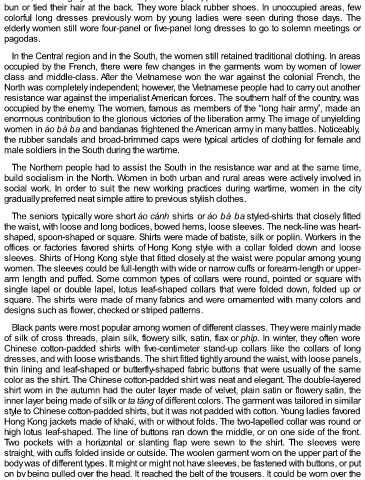Page 277 - Trang Phục Việt Nam
P. 277
in blue, cement gray khaki or warm pink. They wrapped headscarves or wore their hair in a
bun or tied their hair at the back. They wore black rubber shoes. In unoccupied areas, few
colorful long dresses previously worn by young ladies were seen during those days. The
elderly women still wore four-panel or five-panel long dresses to go to solemn meetings or
pagodas.
In the Central region and in the South, the women still retained traditional clothing. In areas
occupied by the French, there were few changes in the garments worn by women of lower
class and middle-class. After the Vietnamese won the war against the colonial French, the
North was completely independent; however, the Vietnamese people had to carry out another
resistance war against the imperialist American forces. The southern half of the country, was
occupied by the enemy. The women, famous as members of the “long hair army”, made an
enormous contribution to the glorious victories of the liberation army. The image of unyielding
women in áo bà ba and bandanas frightened the American army in many battles. Noticeably,
the rubber sandals and broad-brimmed caps were typical articles of clothing for female and
male soldiers in the South during the wartime.
The Northern people had to assist the South in the resistance war and at the same time,
build socialism in the North. Women in both urban and rural areas were actively involved in
social work. In order to suit the new working practices during wartime, women in the city
gradually preferred neat simple attire to previous stylish clothes.
The seniors typically wore short áo cánh shirts or áo bà ba styled-shirts that closely fitted
the waist, with loose and long bodices, bowed hems, loose sleeves. The neck-line was heart-
shaped, spoon-shaped or square. Shirts were made of batiste, silk or poplin. Workers in the
offices or factories favored shirts of Hong Kong style with a collar folded down and loose
sleeves. Shirts of Hong Kong style that fitted closely at the waist were popular among young
women. The sleeves could be full-length with wide or narrow cuffs or forearm-length or upper-
arm length and puffed. Some common types of collars were round, pointed or square with
single lapel or double lapel, lotus leaf-shaped collars that were folded down, folded up or
square. The shirts were made of many fabrics and were ornamented with many colors and
designs such as flower, checked or striped patterns.
Black pants were most popular among women of different classes. They were mainly made
of silk of cross threads, plain silk, flowery silk, satin, flax or phíp. In winter, they often wore
Chinese cotton-padded shirts with five-centimeter stand-up collars like the collars of long
dresses, and with loose wristbands. The shirt fitted tightly around the waist, with loose panels,
thin lining and leaf-shaped or butterfly-shaped fabric buttons that were usually of the same
color as the shirt. The Chinese cotton-padded shirt was neat and elegant. The double-layered
shirt worn in the autumn had the outer layer made of velvet, plain satin or flowery satin, the
inner layer being made of silk or ta tăng of different colors. The garment was tailored in similar
style to Chinese cotton-padded shirts, but it was not padded with cotton. Young ladies favored
Hong Kong jackets made of khaki, with or without folds. The two-lapelled collar was round or
high lotus leaf-shaped. The line of buttons ran down the middle, or on one side of the front.
Two pockets with a horizontal or slanting flap were sewn to the shirt. The sleeves were
straight, with cuffs folded inside or outside. The woolen garment worn on the upper part of the
body was of different types. It might or might not have sleeves, be fastened with buttons, or put
on by being pulled over the head. It reached the belt of the trousers. It could be worn over the

